基本介绍
随着人工智能大模型技术的迅速发展,一种创新的计费模式正在逐渐普及,即以“令牌”(Token)作为衡量使用成本的单位。那么,究竟什么是Token呢?
Token 是一种将自然语言文本转化为计算机可以理解的形式——词向量的手段。这个转化过程涉及对文本进行分词处理,将每个单词、汉字或字符转换为唯一的词向量表示。通过计算这些词向量在模型中的使用次数,服务提供商就能够量化用户所消耗的计算资源,并据此收取费用。
需要注意的是,不同的厂商可能采用不同的方式来定义和计算 Token。一般来说,一个 Token 可能代表一个汉字、一个英文单词,或者一个字符。
在大模型领域,通常情况下,服务商倾向于以千 Tokens(1K Tokens)为单位进行计费。用户可以通过购买一定数量的 Token 来支付模型训练和推理过程中产生的费用。
注意:Token的数量与使用模型的服务次数或数据处理量有关。一般是有梯度的,用得越多可以拿到越便宜的价格,和买东西的道理一样,零售一个价,批发一个价。
如何计算 Tokens 数量?
=======================
具体要怎么计算 Tokens 数量,这个需要官方提供计算方式,或提供接口,或提供源码。
这里以 openAI 的 GPT 为例,介绍 Tokens 的计算方式。
openAI 官方提供了两种计算方式:网页计算、接口计算。
## 网页计算
网页计算顾名思义,就是打开网页输入文字,然后直接计算结果,网页的链接是:https://platform.openai.com/tokenizer。
曾经看到一个粗略的说法:1 个 Token 大约相当于 4 个英文字符或 0.75 个英文单词;而一个汉字则大约需要 1.5 个 Token 来表示。真实性未知,但从个人经验,一个汉字似乎没有达到 1.5 个 Token 这么多。
随意举三个例子:
【例子1】以下十个汉字计算得到的 Token 数是 14 个。
一二三四五六七八九十

【例子2】以下 11 个汉字加2个标点计算得到的 Token 数是 13 个。
今天是十二月一日,星期五。

【例子3】以下 这段话计算得到的 Token 数是 236 个。
人工智能是智能学科重要的组成部分,它企图了解智能的实质,并生产出一种新的能以人类智能相似的方式做出反应的智能机器,该领域的研究包括机器人、语言识别、图像识别、自然语言处理和专家系统等。人工智能从诞生以来,理论和技术日益成熟,应用领域也不断扩大,可以设想,未来人工智能带来的科技产品,将会是人类智慧的“容器”。人工智能可以对人的意识、思维的信息过程的模拟。人工智能不是人的智能,但能像人那样思考、也可能超过人的智能。

接口计算
接下来看看怎么使用 Python 接口实现 Token 计算。
相关链接:https://github.com/openai/openai-cookbook/blob/main/examples/How_to_count_tokens_with_tiktoken.ipynb
从 Note 中可以了解到,要计算 Tokens 需要安装两个第三方包:tiktoken和openai。第一个包不需要 GPT 的 API Key 和 API Secret 便可使用,第二个需要有 GPT 的 API Key 和 API Secret 才能使用,由于某些限制,还需要海外代理。
不过,好消息是openai可以不用,使用tiktoken来计算即可。
先安装tiktoken包:
pip install tiktoken
注:我使用的是 Python 3.9,默认安装的tiktoken版本是 0.5.1。
安装好tiktoken之后,直接看最后两个 cell(In[14] 和 In[15])。

完整代码如下:
def num_tokens_from_messages(messages, model="gpt-3.5-turbo-0613"):
"""Return the number of tokens used by a list of messages."""
try:
encoding = tiktoken.encoding_for_model(model)
except KeyError:
print("Warning: model not found. Using cl100k_base encoding.")
encoding = tiktoken.get_encoding("cl100k_base")
if model in {
"gpt-3.5-turbo-0613",
"gpt-3.5-turbo-16k-0613",
"gpt-4-0314",
"gpt-4-32k-0314",
"gpt-4-0613",
"gpt-4-32k-0613",
}:
tokens_per_message = 3
tokens_per_name = 1
elif model == "gpt-3.5-turbo-0301":
tokens_per_message = 4 # every message follows <|start|>{role/name}\n{content}<|end|>\n
tokens_per_name = -1 # if there's a name, the role is omitted
elif "gpt-3.5-turbo" in model:
print("Warning: gpt-3.5-turbo may update over time. Returning num tokens assuming gpt-3.5-turbo-0613.")
return num_tokens_from_messages(messages, model="gpt-3.5-turbo-0613")
elif "gpt-4" in model:
print("Warning: gpt-4 may update over time. Returning num tokens assuming gpt-4-0613.")
return num_tokens_from_messages(messages, model="gpt-4-0613")
else:
raise NotImplementedError(
f"""num_tokens_from_messages() is not implemented for model {model}. See https://github.com/openai/openai-python/blob/main/chatml.md for information on how messages are converted to tokens."""
)
num_tokens = 0
for message in messages:
num_tokens += tokens_per_message
for key, value in message.items():
num_tokens += len(encoding.encode(value))
if key == "name":
num_tokens += tokens_per_name
num_tokens += 3 # every reply is primed with <|start|>assistant<|message|>
return num_tokens
# let's verify the function above matches the OpenAI API response
import openai
example_messages = [
{
"role": "system",
"content": "You are a helpful, pattern-following assistant that translates corporate jargon into plain English.",
},
{
"role": "system",
"name": "example_user",
"content": "New synergies will help drive top-line growth.",
},
{
"role": "system",
"name": "example_assistant",
"content": "Things working well together will increase revenue.",
},
{
"role": "system",
"name": "example_user",
"content": "Let's circle back when we have more bandwidth to touch base on opportunities for increased leverage.",
},
{
"role": "system",
"name": "example_assistant",
"content": "Let's talk later when we're less busy about how to do better.",
},
{
"role": "user",
"content": "This late pivot means we don't have time to boil the ocean for the client deliverable.",
},
]
for model in [
"gpt-3.5-turbo-0301",
"gpt-3.5-turbo-0613",
"gpt-3.5-turbo",
"gpt-4-0314",
"gpt-4-0613",
"gpt-4",
]:
print(model)
# example token count from the function defined above
print(f"{num_tokens_from_messages(example_messages, model)} prompt tokens counted by num_tokens_from_messages().")
# example token count from the OpenAI API
response = openai.ChatCompletion.create(
model=model,
messages=example_messages,
temperature=0,
max_tokens=1, # we're only counting input tokens here, so let's not waste tokens on the output
)
print(f'{response["usage"]["prompt_tokens"]} prompt tokens counted by the OpenAI API.')
print()
接下来处理一下以上代码,把 In[15] 中,和openai包相关的内容可以直接注释掉,然后执行代码。处理之后,可直接执行代码如下:
import tiktoken
def num_tokens_from_messages(messages, model="gpt-3.5-turbo-0613"):
"""Return the number of tokens used by a list of messages."""
try:
encoding = tiktoken.encoding_for_model(model)
except KeyError:
print("Warning: model not found. Using cl100k_base encoding.")
encoding = tiktoken.get_encoding("cl100k_base")
if model in {
"gpt-3.5-turbo-0613",
"gpt-3.5-turbo-16k-0613",
"gpt-4-0314",
"gpt-4-32k-0314",
"gpt-4-0613",
"gpt-4-32k-0613",
}:
tokens_per_message = 3
tokens_per_name = 1
elif model == "gpt-3.5-turbo-0301":
tokens_per_message = 4 # every message follows <|start|>{role/name}\n{content}<|end|>\n
tokens_per_name = -1 # if there's a name, the role is omitted
elif "gpt-3.5-turbo" in model:
print("Warning: gpt-3.5-turbo may update over time. Returning num tokens assuming gpt-3.5-turbo-0613.")
return num_tokens_from_messages(messages, model="gpt-3.5-turbo-0613")
elif "gpt-4" in model:
print("Warning: gpt-4 may update over time. Returning num tokens assuming gpt-4-0613.")
return num_tokens_from_messages(messages, model="gpt-4-0613")
else:
raise NotImplementedError(
f"""num_tokens_from_messages() is not implemented for model {model}. See https://github.com/openai/openai-python/blob/main/chatml.md for information on how messages are converted to tokens."""
)
num_tokens = 0
for message in messages:
num_tokens += tokens_per_message
for key, value in message.items():
num_tokens += len(encoding.encode(value))
if key == "name":
num_tokens += tokens_per_name
num_tokens += 3 # every reply is primed with <|start|>assistant<|message|>
return num_tokens
# let's verify the function above matches the OpenAI API response
example_messages = [
{
"role": "system",
"content": "You are a helpful, pattern-following assistant that translates corporate jargon into plain English.",
},
{
"role": "system",
"name": "example_user",
"content": "New synergies will help drive top-line growth.",
},
{
"role": "system",
"name": "example_assistant",
"content": "Things working well together will increase revenue.",
},
{
"role": "system",
"name": "example_user",
"content": "Let's circle back when we have more bandwidth to touch base on opportunities for increased leverage.",
},
{
"role": "system",
"name": "example_assistant",
"content": "Let's talk later when we're less busy about how to do better.",
},
{
"role": "user",
"content": "This late pivot means we don't have time to boil the ocean for the client deliverable.",
},
]
for model in [
"gpt-3.5-turbo-0301",
"gpt-3.5-turbo-0613",
"gpt-3.5-turbo",
"gpt-4-0314",
"gpt-4-0613",
"gpt-4",
]:
print(model)
# example token count from the function defined above
print(f"{num_tokens_from_messages(example_messages, model)} prompt tokens counted by num_tokens_from_messages().")
print()
运行结果如下图:

小解析:
-
example_messages变量是一个列表,列表的元素是字典,这个是 GPT 的数据结构,在这个示例代码中,整个列表作为 GPT 的 prompt 输入,所以计算的是整个的 Token 数。 -
不同的模型,对于 prompt 的计算规则有一点点不同,重点在于数据结构多出的字符。
问题1:实际生产中的数据,可能不是这样的,更多时候是存一个字符串,又该怎么处理?
demo 是从列表解析出键content的值,这个比较简单,如果是要从字符串中去解析相关的数据,则需要多加一步转化,使用json包将字符串转化为列表,然后其他的处理方式保持一致即可。
参考如下:
import tiktoken,json
def num_tokens_from_messages(messages, model="gpt-3.5-turbo-0613"):
"""Return the number of tokens used by a list of messages."""
try:
encoding = tiktoken.encoding_for_model(model)
except KeyError:
print("Warning: model not found. Using cl100k_base encoding.")
encoding = tiktoken.get_encoding("cl100k_base")
if model in {
"gpt-3.5-turbo-0613",
"gpt-3.5-turbo-16k-0613",
"gpt-4-0314",
"gpt-4-32k-0314",
"gpt-4-0613",
"gpt-4-32k-0613",
}:
tokens_per_message = 3
tokens_per_name = 1
elif model == "gpt-3.5-turbo-0301":
tokens_per_message = 4 # every message follows <|start|>{role/name}\n{content}<|end|>\n
tokens_per_name = -1 # if there's a name, the role is omitted
elif "gpt-3.5-turbo" in model:
print("Warning: gpt-3.5-turbo may update over time. Returning num tokens assuming gpt-3.5-turbo-0613.")
return num_tokens_from_messages(messages, model="gpt-3.5-turbo-0613")
elif "gpt-4" in model:
print("Warning: gpt-4 may update over time. Returning num tokens assuming gpt-4-0613.")
return num_tokens_from_messages(messages, model="gpt-4-0613")
else:
raise NotImplementedError(
f"""num_tokens_from_messages() is not implemented for model {model}. See https://github.com/openai/openai-python/blob/main/chatml.md for information on how messages are converted to tokens."""
)
# 结构转化,结构不完整则返回0
try:
messages = json.loads(messages)
num_tokens = 0
for message in messages:
num_tokens += tokens_per_message
for key, value in message.items():
num_tokens += len(encoding.encode(value))
if key == "name":
num_tokens += tokens_per_name
num_tokens += 3 # every reply is primed with <|start|>assistant<|message|>
except json.JSONDecodeError:
num_tokens = 0
return num_tokens
# let's verify the function above matches the OpenAI API response
example_messages = [
{
"role": "system",
"content": "You are a helpful, pattern-following assistant that translates corporate jargon into plain English.",
},
{
"role": "system",
"name": "example_user",
"content": "New synergies will help drive top-line growth.",
},
{
"role": "system",
"name": "example_assistant",
"content": "Things working well together will increase revenue.",
},
{
"role": "system",
"name": "example_user",
"content": "Let's circle back when we have more bandwidth to touch base on opportunities for increased leverage.",
},
{
"role": "system",
"name": "example_assistant",
"content": "Let's talk later when we're less busy about how to do better.",
},
{
"role": "user",
"content": "This late pivot means we don't have time to boil the ocean for the client deliverable.",
},
]
example_messages = json.dumps(example_messages)
# 假设使用的是 "gpt-4-0613" 模型
model = "gpt-4-0613"
print(f"{num_tokens_from_messages(example_messages, model)} prompt tokens counted by num_tokens_from_messages().")
问题2:在网页计算小节中使用的字符串跑出来的数据是否和tiktoken一样呢?
实现这个验证很简单,把上面的代码再做简化,直接计算字符串即可。参考逻辑如下:
import tiktoken
def num_tokens_from_messages(messages, model="gpt-3.5-turbo-0613"):
"""Return the number of tokens used by a list of messages."""
try:
encoding = tiktoken.encoding_for_model(model)
except KeyError:
print("Warning: model not found. Using cl100k_base encoding.")
encoding = tiktoken.get_encoding("cl100k_base")
num_tokens = len(encoding.encode(messages))
return num_tokens
str1 = num_tokens_from_messages('一二三四五六七八九十')
str2 = num_tokens_from_messages('今天是十二月一日,星期五。')
str3 = num_tokens_from_messages('人工智能是智能学科重要的组成部分,它企图了解智能的实质,并生产出一种新的能以人类智能相似的方式做出反应的智能机器,该领域的研究包括机器人、语言识别、图像识别、自然语言处理和专家系统等。人工智能从诞生以来,理论和技术日益成熟,应用领域也不断扩大,可以设想,未来人工智能带来的科技产品,将会是人类智慧的“容器”。人工智能可以对人的意识、思维的信息过程的模拟。人工智能不是人的智能,但能像人那样思考、也可能超过人的智能。')
print(f'字符串1长度{str1},字符串2长度{str2},字符串3长度{str3}。')
返回结果如下:

返回结果和网页计算的结果完全一致!
其实这个有点像是 GPT 给我们返回的文本数据,可以直接计算其长度,不需要像上面那么复杂,如果数据结构也是像上面一样,那就需要多加一步解析。
import tiktoken,json
def num_tokens_from_messages(messages):
"""Return the number of tokens used by a list of messages."""
try:
encoding = tiktoken.encoding_for_model(model)
except KeyError:
print("Warning: model not found. Using cl100k_base encoding.")
encoding = tiktoken.get_encoding("cl100k_base")
try:
messages = json.loads(messages)[0]['content']
num_tokens = len(encoding.encode(messages))
except json.JSONDecodeError:
num_tokens = 0
return num_tokens
example_messages = '''[
{
"role": "system",
"content": "一二三四五六七八九十"
}
]'''
print(num_tokens_from_messages(example_messages))
小结
=========
本文主要介绍了 GPT 如何计算 Tokens 的方法,官方提供了两种方式:网页计算和接口计算。
网页计算不需要技术,只需要魔法即可体验,而接口计算,事实上接口计算包含了两种方法,一种使用tiktoken,则需要点 Python 基础,而openai还需要点网络基础和货币基础,需要代理和 plus 账号(20刀/月)等。
如何学习大模型 AI ?
由于新岗位的生产效率,要优于被取代岗位的生产效率,所以实际上整个社会的生产效率是提升的。
但是具体到个人,只能说是:
“最先掌握AI的人,将会比较晚掌握AI的人有竞争优势”。
这句话,放在计算机、互联网、移动互联网的开局时期,都是一样的道理。
作为一名热心肠的互联网老兵,我决定把宝贵的AI知识分享给大家。 至于能学习到多少就看你的学习毅力和能力了 。我已将重要的AI大模型资料包括AI大模型入门学习思维导图、精品AI大模型学习书籍手册、视频教程、实战学习等录播视频免费分享出来。
一、大模型全套的学习路线
学习大型人工智能模型,如GPT-3、BERT或任何其他先进的神经网络模型,需要系统的方法和持续的努力。既然要系统的学习大模型,那么学习路线是必不可少的,下面的这份路线能帮助你快速梳理知识,形成自己的体系。
L1级别:AI大模型时代的华丽登场
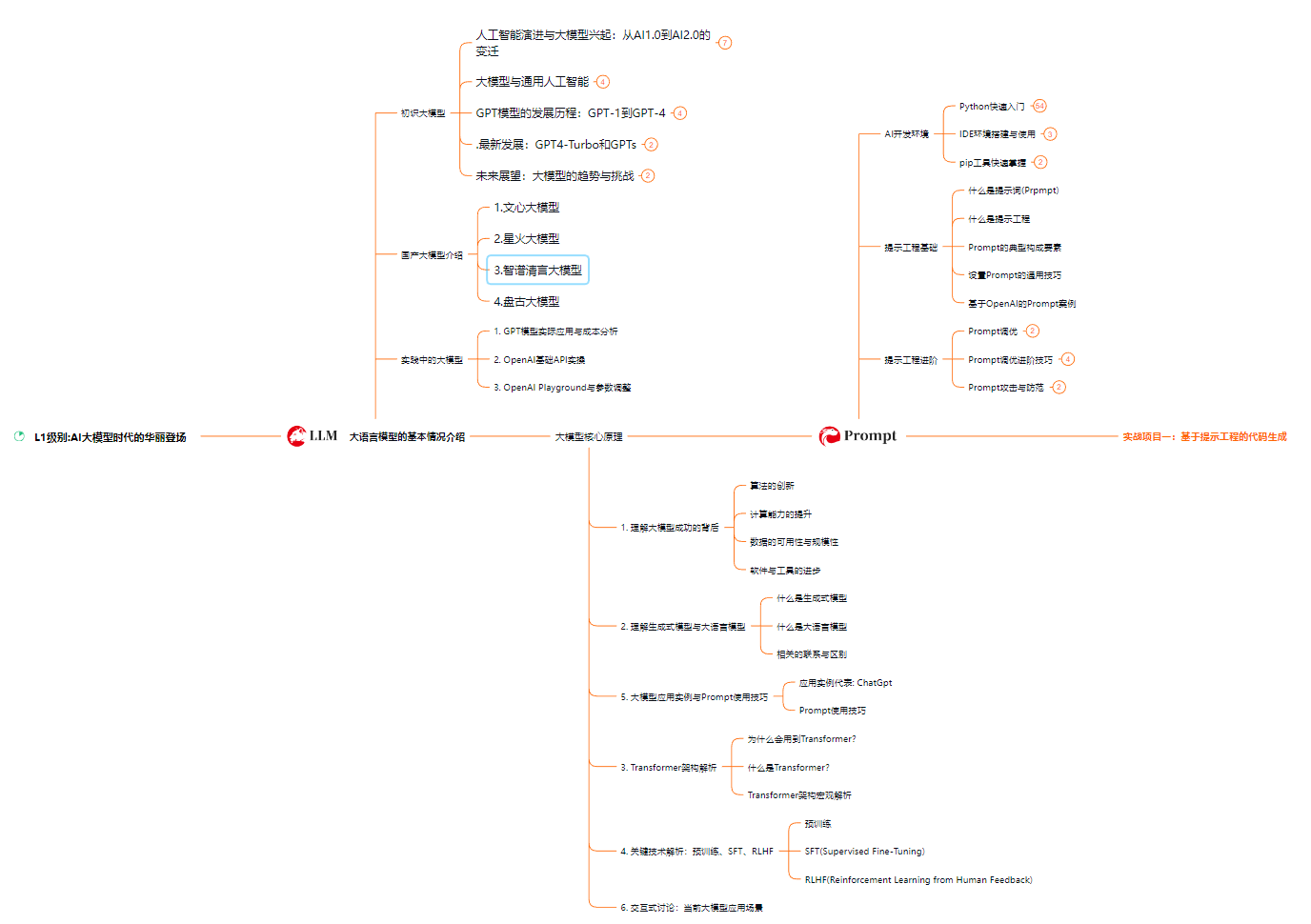
L2级别:AI大模型API应用开发工程
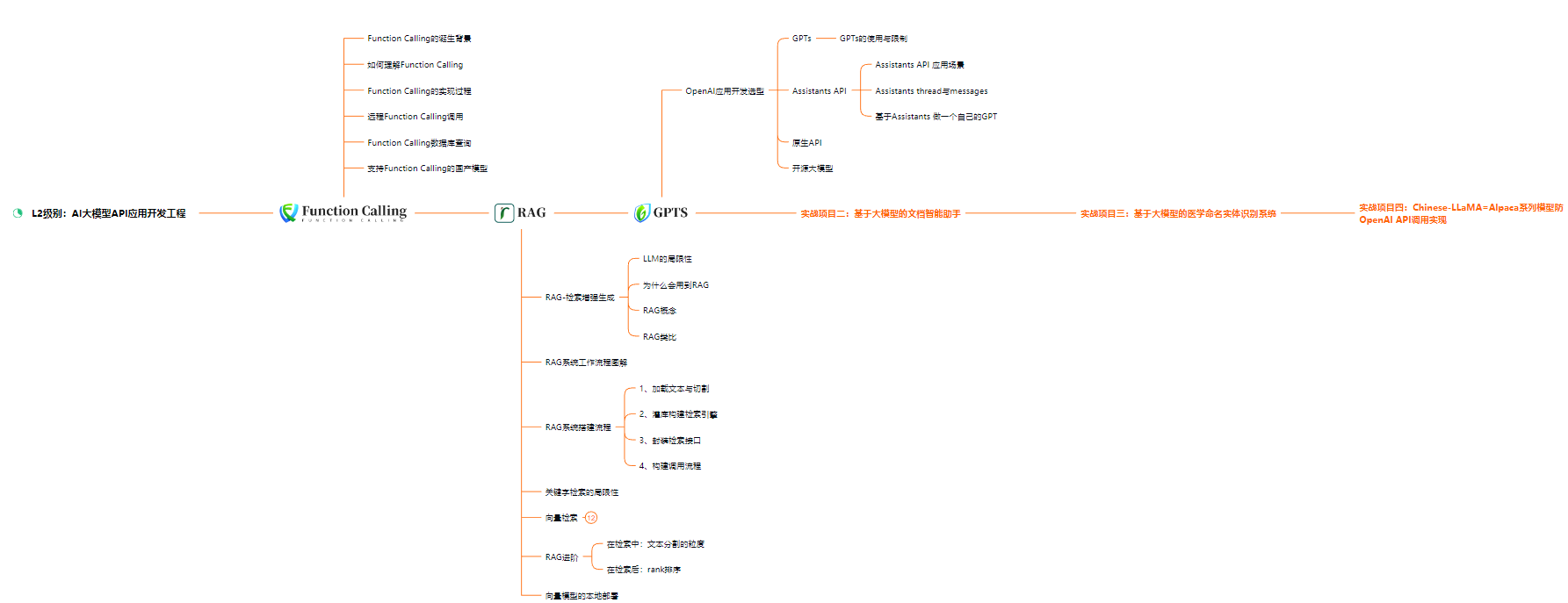
L3级别:大模型应用架构进阶实践

L4级别:大模型微调与私有化部署

一般掌握到第四个级别,市场上大多数岗位都是可以胜任,但要还不是天花板,天花板级别要求更加严格,对于算法和实战是非常苛刻的。建议普通人掌握到L4级别即可。
今天只要你给我的文章点赞,我私藏的大模型学习资料一样免费共享给你们,来看看有哪些东西。
如何学习大模型 AI ?
由于新岗位的生产效率,要优于被取代岗位的生产效率,所以实际上整个社会的生产效率是提升的。
但是具体到个人,只能说是:
“最先掌握AI的人,将会比较晚掌握AI的人有竞争优势”。
我意识到有很多经验和知识值得分享给大家,也可以通过我们的能力和经验解答大家在人工智能学习中的很多困惑,所以在工作繁忙的情况下还是坚持各种整理和分享。但苦于知识传播途径有限,很多互联网行业朋友无法获得正确的资料得到学习提升,故此将并将重要的AI大模型资料包括AI大模型入门学习思维导图、精品AI大模型学习书籍手册、视频教程、实战学习等录播视频免费分享出来。
这份完整版的大模型 AI 学习资料已经上传CSDN,朋友们如果需要可以微信扫描下方CSDN官方认证二维码免费领取【保证100%免费】

一、全套AGI大模型学习路线
AI大模型时代的学习之旅:从基础到前沿,掌握人工智能的核心技能!
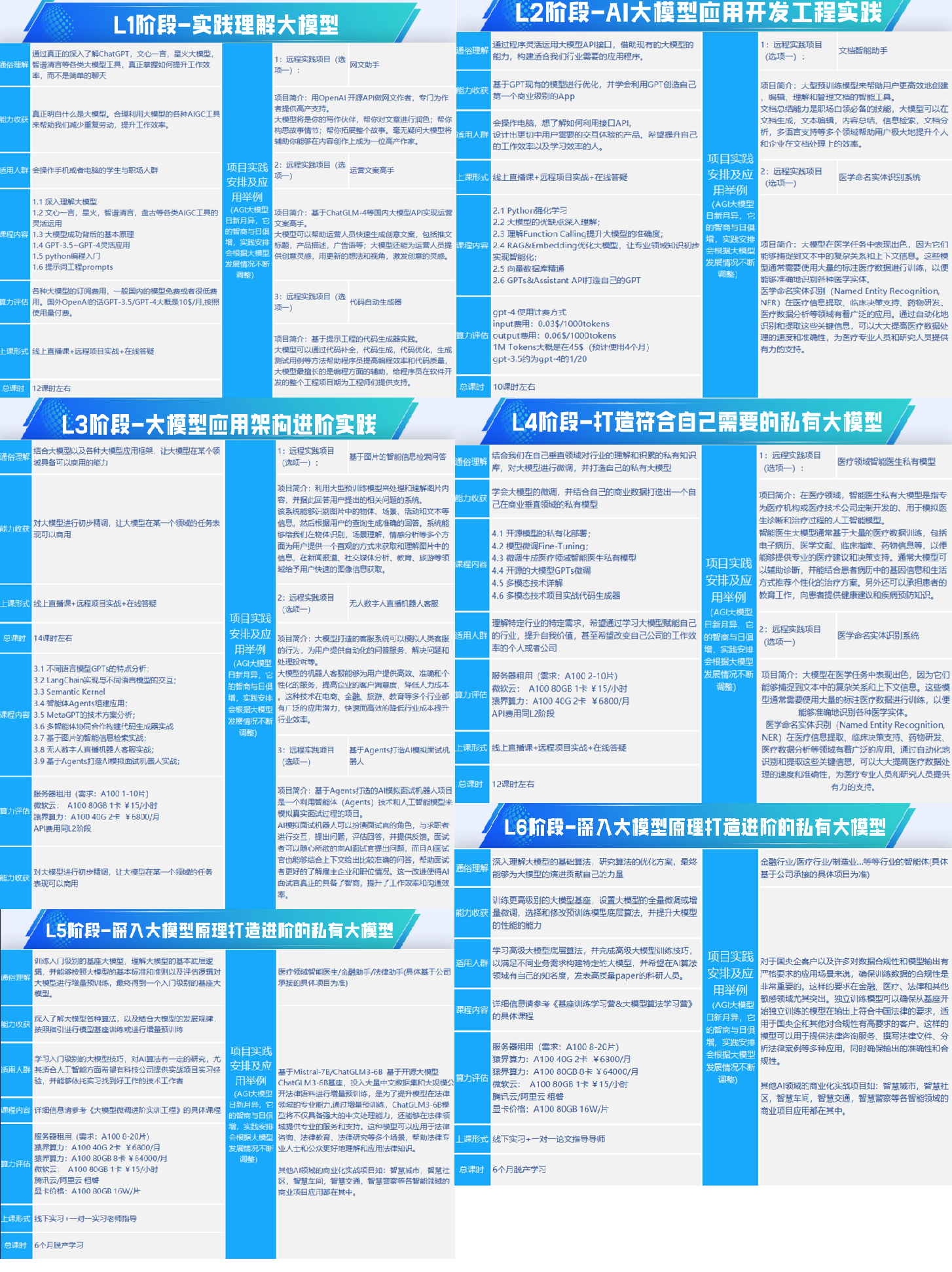
二、640套AI大模型报告合集
这套包含640份报告的合集,涵盖了AI大模型的理论研究、技术实现、行业应用等多个方面。无论您是科研人员、工程师,还是对AI大模型感兴趣的爱好者,这套报告合集都将为您提供宝贵的信息和启示。
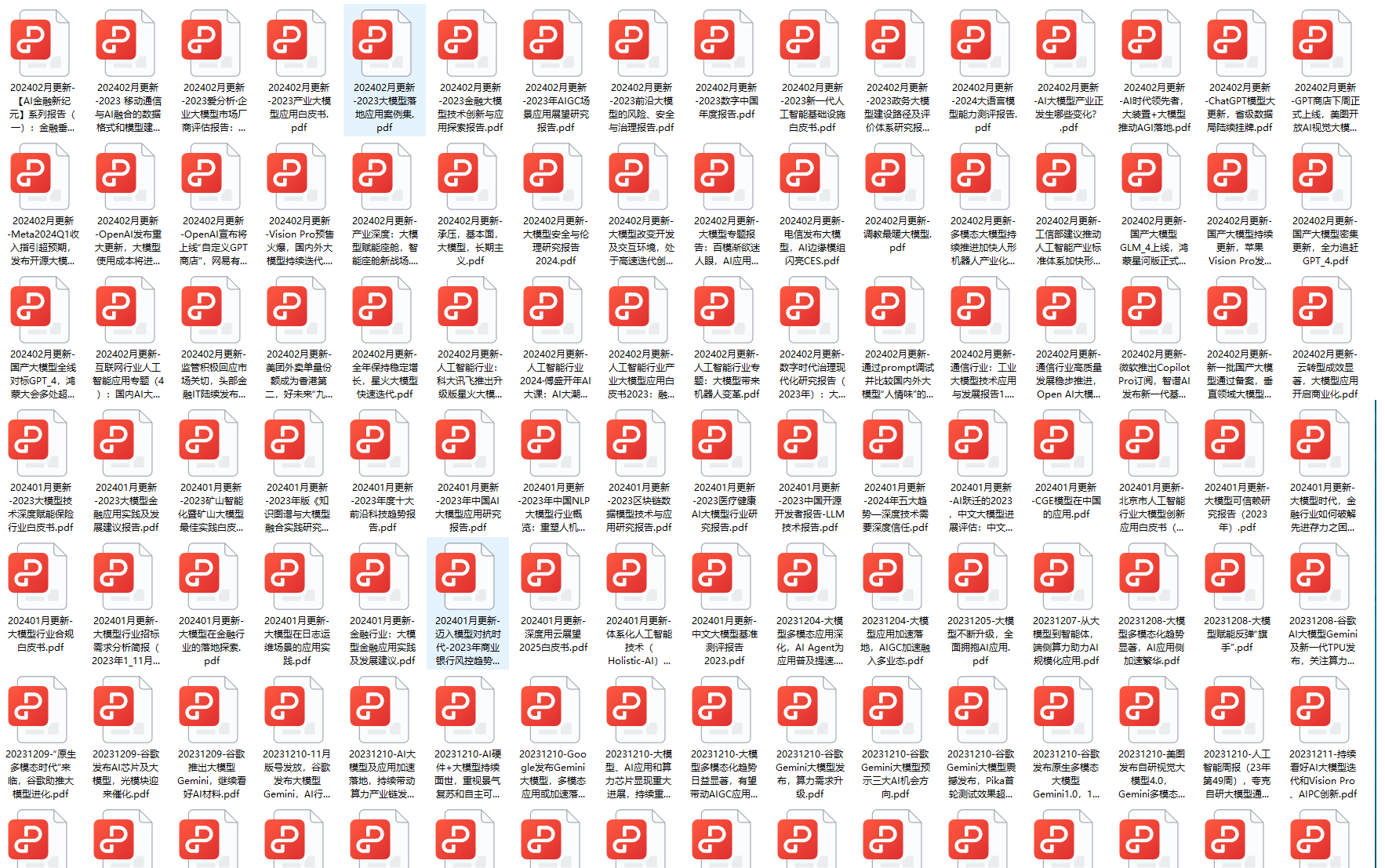
三、AI大模型经典PDF籍
随着人工智能技术的飞速发展,AI大模型已经成为了当今科技领域的一大热点。这些大型预训练模型,如GPT-3、BERT、XLNet等,以其强大的语言理解和生成能力,正在改变我们对人工智能的认识。 那以下这些PDF籍就是非常不错的学习资源。
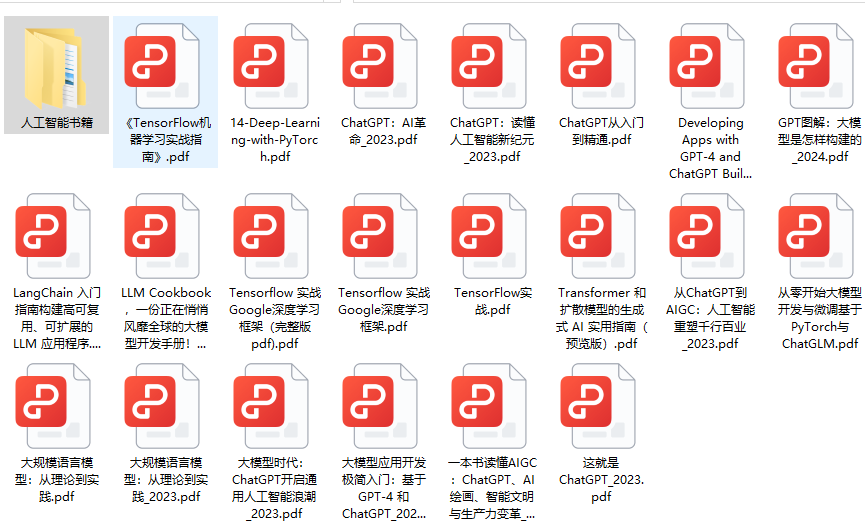
四、AI大模型商业化落地方案

作为普通人,入局大模型时代需要持续学习和实践,不断提高自己的技能和认知水平,同时也需要有责任感和伦理意识,为人工智能的健康发展贡献力量。

第一阶段(10天):初阶应用
该阶段让大家对大模型 AI有一个最前沿的认识,对大模型 AI 的理解超过 95% 的人,可以在相关讨论时发表高级、不跟风、又接地气的见解,别人只会和 AI 聊天,而你能调教 AI,并能用代码将大模型和业务衔接。
- 大模型 AI 能干什么?
- 大模型是怎样获得「智能」的?
- 用好 AI 的核心心法
- 大模型应用业务架构
- 大模型应用技术架构
- 代码示例:向 GPT-3.5 灌入新知识
- 提示工程的意义和核心思想
- Prompt 典型构成
- 指令调优方法论
- 思维链和思维树
- Prompt 攻击和防范
- …
第二阶段(30天):高阶应用
该阶段我们正式进入大模型 AI 进阶实战学习,学会构造私有知识库,扩展 AI 的能力。快速开发一个完整的基于 agent 对话机器人。掌握功能最强的大模型开发框架,抓住最新的技术进展,适合 Python 和 JavaScript 程序员。
- 为什么要做 RAG
- 搭建一个简单的 ChatPDF
- 检索的基础概念
- 什么是向量表示(Embeddings)
- 向量数据库与向量检索
- 基于向量检索的 RAG
- 搭建 RAG 系统的扩展知识
- 混合检索与 RAG-Fusion 简介
- 向量模型本地部署
- …
第三阶段(30天):模型训练
恭喜你,如果学到这里,你基本可以找到一份大模型 AI相关的工作,自己也能训练 GPT 了!通过微调,训练自己的垂直大模型,能独立训练开源多模态大模型,掌握更多技术方案。
到此为止,大概2个月的时间。你已经成为了一名“AI小子”。那么你还想往下探索吗?
- 为什么要做 RAG
- 什么是模型
- 什么是模型训练
- 求解器 & 损失函数简介
- 小实验2:手写一个简单的神经网络并训练它
- 什么是训练/预训练/微调/轻量化微调
- Transformer结构简介
- 轻量化微调
- 实验数据集的构建
- …
第四阶段(20天):商业闭环
对全球大模型从性能、吞吐量、成本等方面有一定的认知,可以在云端和本地等多种环境下部署大模型,找到适合自己的项目/创业方向,做一名被 AI 武装的产品经理。
- 硬件选型
- 带你了解全球大模型
- 使用国产大模型服务
- 搭建 OpenAI 代理
- 热身:基于阿里云 PAI 部署 Stable Diffusion
- 在本地计算机运行大模型
- 大模型的私有化部署
- 基于 vLLM 部署大模型
- 案例:如何优雅地在阿里云私有部署开源大模型
- 部署一套开源 LLM 项目
- 内容安全
- 互联网信息服务算法备案
- …
学习是一个过程,只要学习就会有挑战。天道酬勤,你越努力,就会成为越优秀的自己。
如果你能在15天内完成所有的任务,那你堪称天才。然而,如果你能完成 60-70% 的内容,你就已经开始具备成为一名大模型 AI 的正确特征了。
这份完整版的大模型 AI 学习资料已经上传CSDN,朋友们如果需要可以微信扫描下方CSDN官方认证二维码免费领取【保证100%免费】
























 2758
2758

 被折叠的 条评论
为什么被折叠?
被折叠的 条评论
为什么被折叠?








